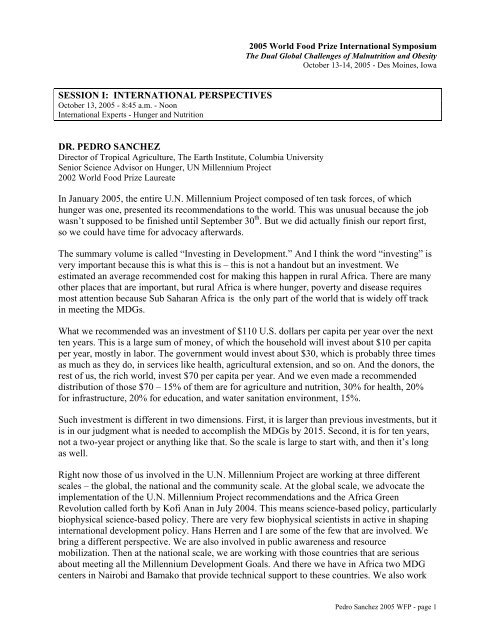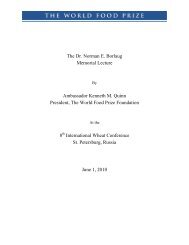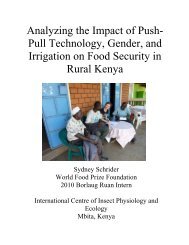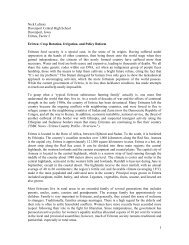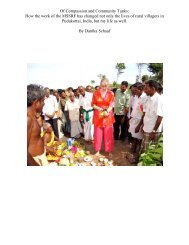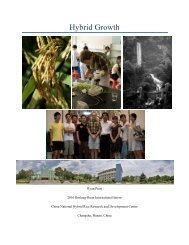transcript - The World Food Prize
transcript - The World Food Prize
transcript - The World Food Prize
Create successful ePaper yourself
Turn your PDF publications into a flip-book with our unique Google optimized e-Paper software.
2005 <strong>World</strong> <strong>Food</strong> <strong>Prize</strong> International Symposium<br />
<strong>The</strong> Dual Global Challenges of Malnutrition and Obesity<br />
October 13-14, 2005 - Des Moines, Iowa<br />
SESSION I: INTERNATIONAL PERSPECTIVES<br />
October 13, 2005 - 8:45 a.m. - Noon<br />
International Experts - Hunger and Nutrition<br />
DR. PEDRO SANCHEZ<br />
Director of Tropical Agriculture, <strong>The</strong> Earth Institute, Columbia University<br />
Senior Science Advisor on Hunger, UN Millennium Project<br />
2002 <strong>World</strong> <strong>Food</strong> <strong>Prize</strong> Laureate<br />
In January 2005, the entire U.N. Millennium Project composed of ten task forces, of which<br />
hunger was one, presented its recommendations to the world. This was unusual because the job<br />
wasn’t supposed to be finished until September 30 th . But we did actually finish our report first,<br />
so we could have time for advocacy afterwards.<br />
<strong>The</strong> summary volume is called “Investing in Development.” And I think the word “investing” is<br />
very important because this is what this is – this is not a handout but an investment. We<br />
estimated an average recommended cost for making this happen in rural Africa. <strong>The</strong>re are many<br />
other places that are important, but rural Africa is where hunger, poverty and disease requires<br />
most attention because Sub Saharan Africa is the only part of the world that is widely off track<br />
in meeting the MDGs.<br />
What we recommended was an investment of $110 U.S. dollars per capita per year over the next<br />
ten years. This is a large sum of money, of which the household will invest about $10 per capita<br />
per year, mostly in labor. <strong>The</strong> government would invest about $30, which is probably three times<br />
as much as they do, in services like health, agricultural extension, and so on. And the donors, the<br />
rest of us, the rich world, invest $70 per capita per year. And we even made a recommended<br />
distribution of those $70 – 15% of them are for agriculture and nutrition, 30% for health, 20%<br />
for infrastructure, 20% for education, and water sanitation environment, 15%.<br />
Such investment is different in two dimensions. First, it is larger than previous investments, but it<br />
is in our judgment what is needed to accomplish the MDGs by 2015. Second, it is for ten years,<br />
not a two-year project or anything like that. So the scale is large to start with, and then it’s long<br />
as well.<br />
Right now those of us involved in the U.N. Millennium Project are working at three different<br />
scales – the global, the national and the community scale. At the global scale, we advocate the<br />
implementation of the U.N. Millennium Project recommendations and the Africa Green<br />
Revolution called forth by Kofi Anan in July 2004. This means science-based policy, particularly<br />
biophysical science-based policy. <strong>The</strong>re are very few biophysical scientists in active in shaping<br />
international development policy. Hans Herren and I are some of the few that are involved. We<br />
bring a different perspective. We are also involved in public awareness and resource<br />
mobilization. <strong>The</strong>n at the national scale, we are working with those countries that are serious<br />
about meeting all the Millennium Development Goals. And there we have in Africa two MDG<br />
centers in Nairobi and Bamako that provide technical support to these countries. We also work<br />
Pedro Sanchez 2005 WFP - page 1
very closely with NEPAD, in national planning, enabling polices and scaling up. And then on the<br />
community scale, the Millennium Villages – a new approach based on an old paradigm—what<br />
happens is at the community scale. This is where things get done.<br />
Global advocacy includes working with the United Nations and with leaders of governments,<br />
supporting the African Green Revolution, supporting the Blair Commission on Africa,<br />
supporting the Gleneagles G8 Summit, and very much the just-finished U.N. New York Summit<br />
concluded about three weeks ago.<br />
That U.N. Summit, on September 16 th , the General Assembly passed a resolution, approved by<br />
all member governments, stating that all countries recommit themselves to achieve the<br />
Millennium Development Goals. This is particularly important because President Bush, for the<br />
first time he said to the General Assembly and the world – “<strong>The</strong> U.N. is behind making these<br />
MDGs happen.” And the actual words were used; they had not been before. So this is very<br />
reassuring.<br />
All countries also support Kofi Anan’s goal for an African Green Revolution. And in that<br />
declaration, all countries support specific interventions such as homegrown school feeding<br />
programs, and we will talk about that later, malaria bed nets and things of that… So this is a very<br />
important political breakthrough. Even the U.N. Summit didn’t succeed in tackling issues of the<br />
Security Council, but it certainly succeeded in tackling issues of development.<br />
Advocacy goes also in different ways. My colleague Jeffrey Sachs just starred with Actress<br />
Angelina Jolie on MTV, aimed at young people to make them aware of what’s happening in the<br />
villages. And I was given the task to do that with AARP, so I didn’t get the best part of that. Jeff<br />
Sachs is talking to the teenagers, and I’m talking to the geezers! <strong>The</strong>y’re both very important<br />
constituencies.<br />
As I mentioned before, on July 5 th , 2004, at a special meeting right before the African Union<br />
Summit, and that is last year, Secretary General Kofi Anan called for an African Green<br />
Revolution, saying that the old Green Revolution that helped so much Asia, Latin America and<br />
Middle East did not have a discernible impact in Africa, and Africa needed its own kind. And he<br />
called it a uniquely African Green Revolution for the 21 st Century.<br />
This uniquely African Green Revolution has several components. It has agriculture, increasing<br />
agricultural productivity, like the old Green Revolution, but putting special emphasis on<br />
replenishing soil health and improving water management at the entry points.<br />
It involves human nutrition, and I must say Kofi Anan has made an impact in bringing<br />
agriculture and human nutrition together. In the Hunger Task Force it was a fantastic experience<br />
working with nutritionists like Abenaa, Patrick Webb and others, which made me realize how<br />
ignorant I, as an agriculturalist was, of human nutrition, and vice versa. Agriculture and nutrition<br />
must go together, and that’s why I’m also very excited about the symposium here.<br />
But it also involves markets, making markets for the poor. Markets do not work for the poor;<br />
they’re not designed to do so, I’ve been told by economists. Also, all has to be done in<br />
environmentally positive ways, and we have learned a lot of lessons here and certainly pollution<br />
lessons we don’t want to repeat in developing countries.<br />
Pedro Sanchez 2005 WFP - page 2
And the African Green Revolution also involves the very large role of polices, enabling policies,<br />
as well as politics.<br />
So these are the six components of the African Green Revolution.<br />
<strong>The</strong> overarching biophysical problem in Africa is not the lack of improved varieties. It’s not the<br />
lack of biotechnology. It’s not any other stuff. <strong>The</strong> first things first – the overwhelming problems<br />
are: Unhealthy soils, soils that have been depleted of nutrients and many times eroded out<br />
because of desperate farming practices; and untamed water, either too much or too little water.<br />
So those are the entry points. After they are tackled, this is when you can take advantage of the<br />
enormous potential of genetic improvements. <strong>The</strong> Hunger Task Force supports crop<br />
biotechnology because it’s scientifically correct, and we have said so very, very clearly.<br />
Now, on nutrition, one of our main recommendations is homegrown feeding programs for<br />
schools and for infants and pregnant, lactating mothers, and those destitute people who are<br />
usually very, very sick or already affected by HIV-AIDS.<br />
<strong>The</strong> advantage of this, as opposed to sending food from rich countries is that locally grown meals<br />
can provide balanced nutrition. This would include all the micronutrients, all the things that<br />
we’ve been talking about on fortification, supplementation, and biofortification. It also makes<br />
sense in terms that it suits local tastes.<br />
And also, a study that IFPRI did commissioned by the Hunger Task Force showed that if half of<br />
the primary schools in Africa implement homegrown feeding programs, it would increase the<br />
local demand for basic crops such as maize by 25%. That’s a big number, because the amount of<br />
maize that is imported right now into Africa is 14% of the total production.<br />
And then – we don’t have any data on this – but it would increase the demand for pulses like<br />
soybeans, livestock products, milk and meat, horticulture products, fruits and vegetables by<br />
orders of magnitude, because there would be a large market there. We feel this is a much more<br />
effective than food aid.<br />
In the Hunger Task Force report we found that 90% of the hungry people in the world are<br />
chronically hungry people. <strong>The</strong>y are the people that do not starve but die of malnutrition-related<br />
diseases, as Patrick Webb put it so well this morning. Only 10% are acutely hungry, in starvation<br />
situations caused by wars and natural disasters. <strong>The</strong>y need food aid, no question about it,<br />
regardless. But for the 90% of the hungry, its homegrown feeding we need.<br />
<strong>The</strong> basic philosophy we’re advocating in the report of the Hunger Task Force is to invest in the<br />
front end of the food chain rather than the tail end of it. So you go from soil, water, inputs down<br />
to crops, harvested products, marketing, processing supermarkets, cooking, eating, utilization<br />
and so on. What we’re saying is – Invest here and not on the tail end, which is food aid. Studies<br />
in Malawi by FAO show that investing in soils and improved seeds, are three to four times more<br />
cost effective than investing in food aid.<br />
A couple days ago (October 11 th ) there was an Op-Ed article in the New York Times by Nicholas<br />
Kristoff, and I put some copies outside. It’s titled, “Year After Year, Grave After Grave,” and it<br />
addresses this issue. We try to keep food aid going for the chronically hungry for reasons other<br />
Pedro Sanchez 2005 WFP - page 3
than helping people feed themselves in Africa. And I think it’s about that we really have to<br />
decide whether we’re helping the people who are hungry, or helping preserve the status quo.<br />
At the national scale: <strong>The</strong>re has to be buy-in from the top. And you see some fancy meetings<br />
there with heads of states shown in the slides. This is something I learned from Norm Borlaug.<br />
He said, “You go to the top, and you put pressure on those people.” And so we’re doing that.<br />
We’re working with ten countries in Africa that are reasonably well governed, countries like<br />
Ethiopia, Kenya, Ghana, Mali, Malawi, Nigeria, Rwanda, Senegal, Tanzania and Uganda.<br />
<strong>The</strong>y’re not perfect, they’re not governed by Mother Teresa, but neither are we. So don’t expect<br />
perfection, but these are reasonable governed countries. And there are more like <strong>The</strong> Gambia as<br />
well. <strong>The</strong>se countries are reasonably committed to making the MDGs happen.<br />
So there we have these two MDG centers that have a small group of specialists. <strong>The</strong>y are located<br />
at international centers. <strong>The</strong> one in Nairobi is located at ICRAF, and the one in Bamako is<br />
located at ICRISAT. And the idea there is to provide some technical capacity so the governments<br />
can do their strategic budgeting, their PRSPs, things like that, make sure that they put in their<br />
budgets funding to achieve the MDGs.<br />
And this is one great fallacy: paying lip-service to the Millennium Development Goals. I have<br />
heard time and time again, – “Here’s our new strategic plan, Pedro”, they tell me. On page 1 it<br />
describes all the Millennium Development Goals, saying we are committed, and this strategy<br />
will show you how we contribute to achieving the MDGs. At the end it says, “So you see we are<br />
contributing to the Millennium Development Goals.” In the middle there’s nothing, nothing<br />
explicit, nothing reflecting the investments that are needed in health and in agriculture and so on.<br />
<strong>The</strong> Hunger Task Force recommended that the budget of the CGIAR be raised to one billion<br />
dollars a year for additional research, including human nutrition, additional research that would<br />
directly address many of the Millennium Development Goals. That offer stands – we’re ready to<br />
start the political action on that, Per. But I would like to see explicitly how the CGIAR would do<br />
that and not just saying, “Well, we’re going to help alleviate hunger and poverty alone.”<br />
<strong>The</strong> MDG Centers are also asking the government – What is your response to Kofi Anan’s call<br />
for an African Green Revolution In the case of Kenya, President Kibaki says, “Let’s do it,” and<br />
started a program called, Njaa Marufuku Kenya, which in Swahili means “banish hunger in<br />
Kenya.” But they’re also in Uganda, Tanzania, Mali and Ghana.<br />
Now, the community scale: Millennium Villages. What does it take for a typical, impoverished<br />
African village of about 5,000 people to accomplish all the Millennium Development Goals in<br />
ten years Using the budget that we proposed in the U.N. Millennium Project, two villages were<br />
started this year Sauri in Siaya District in Western Kenya and Koraro in Tigray Region, Ethiopia.<br />
<strong>The</strong> work started with the villages assuming ownership and responsibility. When asked about the<br />
Millennium Development Goals, no-brainers – people understand it right away. What do you<br />
need What would you do about it And a lot of community action, a lot of capacity building<br />
courses. Villagers come in and say, “Oh, I didn’t know I’m a stakeholder,” and stuff like that,<br />
and they develop very good business plans, actually pretty good log-frames.<br />
Pedro Sanchez 2005 WFP - page 4
<strong>The</strong> villagers are organized by themselves into committees such as water, agriculture, health,<br />
electricity, energy, schools, just about everything. And right now the Kenyan village developed<br />
its own constitution, elected an executive committee with a woman as chair, a person who<br />
doesn’t even speak English. I think that says a lot.<br />
<strong>The</strong> Kenyan villagers basically asked for two things. “We need a clinic, and we need farm<br />
inputs.” So we said, “Build a clinic,” so they did. <strong>The</strong>y built a clinic in about six weeks, starting<br />
from scratch. <strong>The</strong>y made the bricks. <strong>The</strong> clinic was built according to specifications of the<br />
Ministry of Health. <strong>The</strong> donor (us) provided the roofing material, cement, paint and generator.<br />
<strong>The</strong> Ministry of Health has provided nurses and clinical officers.<br />
<strong>The</strong> clinic now has a capacity to diagnose malaria, deliver anti-retroviral drugs after doctors were<br />
trained on that, and has distributed 3,000 long-lasting insecticide treated malaria bed nets so<br />
everybody in the village is now sleeping under a bednet. <strong>The</strong>y were given free of charge, but if<br />
one accounts for the labor that these people have put in organizing themselves into the different<br />
committees and in physically building the clinic itself, I am sure it exceeds the $5 cost of each<br />
bednet.<br />
In February 2005 the Sauri Agricultural Committee decided to invest in fertilizers, hybrid maize<br />
seed and agroforestry seeds. <strong>The</strong> project procured enough fertilizer to give a shot of 90 kg of<br />
nitrogen per hectare and 50 kg of phosphorus (P, not P2O5) because this phosphorous-deficient<br />
area. And the best hybrid seed from a local company that CIMMYT recommended. <strong>The</strong><br />
distribution was done by the villagers. <strong>The</strong> result was a fantastic maize crop, averaging 4.9<br />
tons/ha (91 bushels/acre) crop, while outside of the village the average was closer to 1.2 tons/ha<br />
(22 bushel/acre). <strong>The</strong>y’re literally swimming in maize, and they had a very good harvest festival.<br />
You see some familiar faces there, like Ann Veneman, Executive Director of UNICEF there, and<br />
Health Minister Charity Ngilu. This has transformed the village. People look at you differently.<br />
You sense hope and empowerment. <strong>The</strong>y feel that they can control their destiny, and they want<br />
to contribute.<br />
Marketing of a surplus crop is a major challenge. So, with the help of the Rockefeller Foundation<br />
sponsored NGO-called SACRED Africa, a cereal bank has been created, where maize is safely<br />
stored and can be sold in bulk for a better price. And part of the deal was that farmers had to give<br />
10% of their crop to the schools for school feeding programs. And what you see in the picture<br />
there is already the 10% that the farmers have delivered. <strong>The</strong>y’re put in a government depot,<br />
which is safe, just pay rent to the government, and there is enough food there, there is enough<br />
maize to feed the 1500 school kids for a whole year.<br />
<strong>The</strong>n the villagers recognized that out of a thousand households, 40 of them were really destitute.<br />
<strong>The</strong>y had a big harvest, but they couldn’t store it in their crumbling, leaky homes right, so roofs<br />
were fixed by the villagers. <strong>The</strong> project provided roofing material<br />
Next season. About 5.5 million nitrogen-fixing trees have been planted by the villagers, so they<br />
will depend on nitrogen fixation of agroforestry trees for most of the nitrogen, supplemented<br />
with fertilizers as needed, move to high-value crops.<br />
Energy – moving into rechargeable lanterns that are much more effective than the kerosene<br />
burners.<br />
Pedro Sanchez 2005 WFP - page 5
Water and sanitation – trying to fix the watering holes in places like that is very difficult.<br />
Environmental regeneration, especially in Ethiopia, where the topsoil is gone, is proceeding very<br />
rapidly.<br />
And in education, the school feeding programs and good leadership has taken this school from<br />
being 380 and something out of 500 primary schools in terms of national examinations in the<br />
district to No. 2.<br />
Also, Motorola Foundation announced a grant to provide wireless Internet to the first two<br />
villages. And what you see here is the first e-mail sent by schoolchildren from these villages to<br />
Secretary General Kofi Anan saying, “My name is Paul. I want to be a doctor.” “My name is<br />
Nancy. I want to be an airline pilot.” <strong>The</strong>se kids now can do that.<br />
Scaling up: We have obtained funding from the government of Japan for scaling up from these<br />
two villages to twelve in the different agroecological zones covering all the different<br />
agroecological zones in Subsahara in Africa, with the exception of commercial agriculture in<br />
South Africa, paddy rice in Madagascar. <strong>The</strong>se villages are going on in ten countries right now,<br />
in Uganda, Mali, Ghana, Malawi, Tanzania, Nigeria, Senegal and Rwanda.<br />
And there’s so much interest in this that there’s expansion to what we would call Millennium<br />
Villages Type II, which are not research villages, but to expand around the Millennium Villages<br />
Type I. A not-for-profit NGO has been created called MillenniumPromise.org to accept financial<br />
contributions from the private sector to fund these villages.<br />
So to finish up, I’d like to update the old Confucius proverb: “Give people a fish and they will<br />
eat for a day” – that’s dependency. That’s what we do a lot with food aid for the chronically<br />
hungry. “Show them how to fish, and they will eat for a lifetime” – that’s empowerment. To this<br />
I would like to add “And then they will buy fishing equipment” and that means trade and poverty<br />
elimination.<br />
Pedro Sanchez 2005 WFP - page 6


